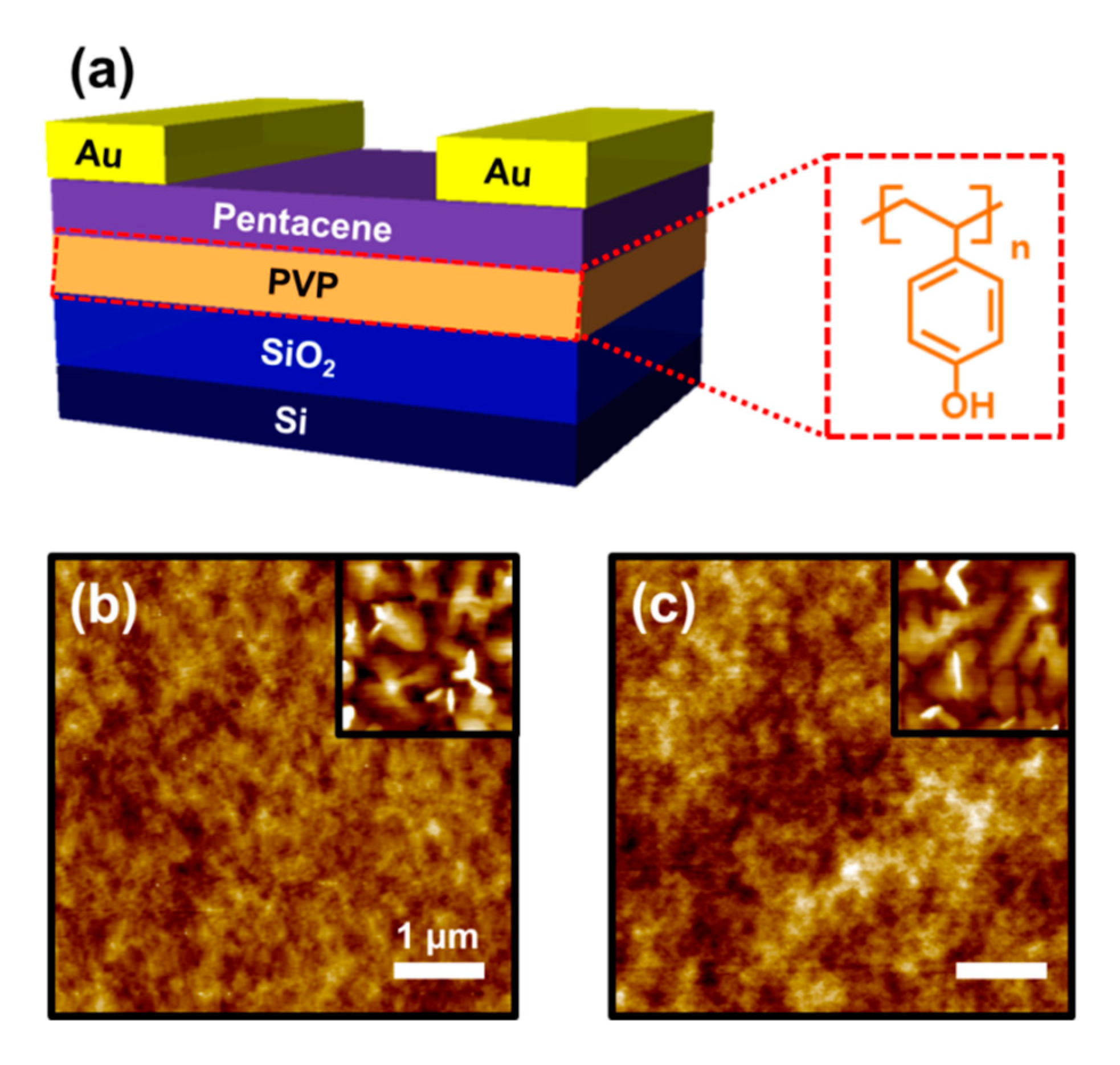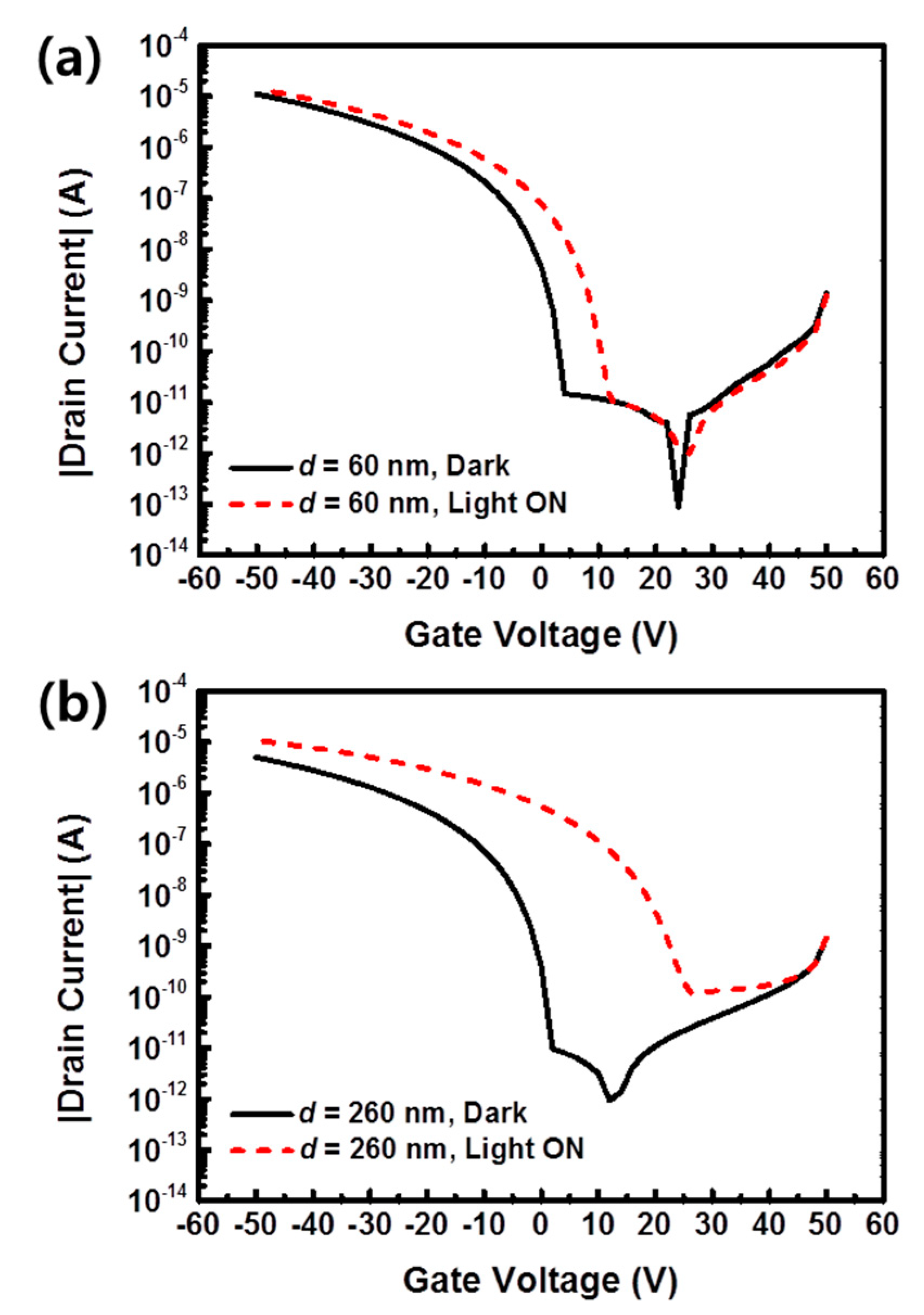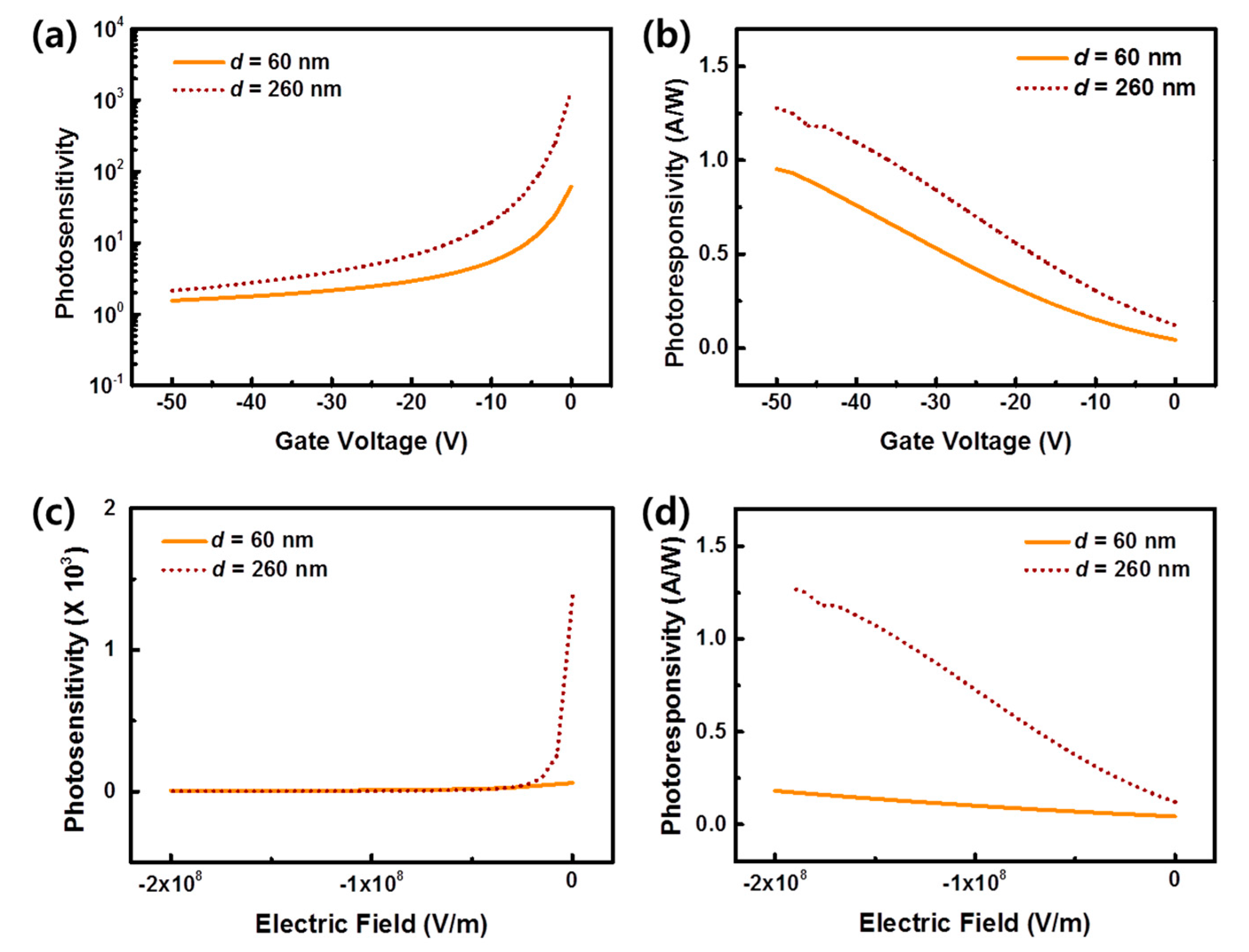Improvement of Photoresponse in Organic Phototransistors through Bulk Effect of Photoresponsive Gate Insulators
Abstract
1. Introduction
2. Materials and Methods
3. Results and Discussion
4. Conclusions
Supplementary Materials
Author Contributions
Funding
Conflicts of Interest
References
- Tsai, W.-W.; Chao, Y.-C.; Chen, E.-C.; Zan, H.-W.; Meng, H.-F.; Hsu, C.S. Increasing organic vertical carrier mobility for the application of high speed bilayered organic photodetector. Appl. Phys. Lett. 2009, 95, 213308. [Google Scholar] [CrossRef]
- Dwivedi, A.; Singh, A.; Prakash, R.; Chakrabarti, P. A proposed organic Schottky barrier photodetector for application in the visible region. Curr. Appl. Phys. 2010, 10, 900–903. [Google Scholar] [CrossRef]
- Kim, D.-H.; Kim, K.-S.; Shim, H.-S.; Moon, C.-K.; Jin, Y.W.; Kim, J.-J. A high performance semitransparent organic photodetector with green color selectivity. Appl. Phys. Lett. 2014, 105, 213301. [Google Scholar] [CrossRef]
- Zhang, H.; Jenatsch, S.; De Jonghe, J.; Nüesch, F.; Steim, R.; Véron, A.C.; Hany, R. Transparent Organic Photodetector using a Near-Infrared Absorbing Cyanine Dye. Sci. Rep. 2015, 5, 9439. [Google Scholar] [CrossRef] [PubMed]
- Han, S.-T.; Peng, H.; Sun, Q.; Venkatesh, S.; Chung, K.S.; Lau, S.C.; Zhou, Y.; Roy, V.A.L. An Overview of the Development of Flexible Sensors. Adv. Mater. 2017, 29, 1700375. [Google Scholar] [CrossRef]
- Fu, L.-N.; Leng, B.; Li, Y.; Gao, X.-K. Photoresponsive organic field-effect transistors involving photochromic molecules. Chin. Chem. Lett. 2016, 27, 1319–1329. [Google Scholar] [CrossRef]
- Jerca, V.V.; Jerca, V.V.; Rau, I.; Manea, A.M.; Vuluga, D.M.; Kajzar, F. Advances in understanding the photoresponsive behavior of azobenzenes substituted with strong electron withdrawing groups. Opt. Mater. 2015, 48, 160–164. [Google Scholar] [CrossRef]
- Jerca, V.V.; Hoogenboom, R. Photocontrol in Complex Polymeric Materials: Fact or Illusion? Angew. Chem. Int. Ed. 2018, 57, 7945–7947. [Google Scholar] [CrossRef]
- Smithson, C.S.; Ljubic, D.; Wu, Y.; Zhu, S. The effect of azobenzene derivatives on UV-responsive organic thin-film transistors with a 2,7-dipentylbenzo[b]benzo[4,5]thieno[2,3-d]thiophene semiconductor. J. Mater. Chem. C 2015, 3, 8090–8096. [Google Scholar] [CrossRef]
- Lee, W.H.; Choi, H.H.; Kim, D.H.; Cho, K. Microstructure dependent bias stability of organic transistors. Adv. Mater. 2014, 26, 1660. [Google Scholar] [CrossRef]
- Sirringhaus, H. Device Physics of Solution-Processed Organic Field-Effect Transistors. Adv. Mater. 2005, 17, 2411–2425. [Google Scholar] [CrossRef]
- Zhao, X.; Tang, Q.; Tian, H.; Tong, Y.; Liu, Y. Highly photosensitive thienoacene single crystal microplate transistors via optimized dielectric. Org. Electron. 2015, 16, 171–176. [Google Scholar] [CrossRef]
- Zhao, Y.; Dong, G.; Wang, L.; Qiu, Y. Improved photostability of organic thin film transistors with tantalum oxide/poly(4-vinylphenol) double gate insulators. Appl. Phys. Lett. 2007, 90, 252110. [Google Scholar] [CrossRef]
- Kim, J.; Cho, S.; Kim, Y.-H.; Park, S.K. Highly-sensitive solution-processed 2,8-difluoro-5,11-bis(triethylsilylethynyl) anthradithiophene (diF-TESADT) phototransistors for optical sensing applications. Org. Electron. 2014, 15, 2099–2106. [Google Scholar] [CrossRef]
- Salinas, M.; Halik, M. Photoactive self-assembled monolayers for optically switchable organic thin-film transistors. Appl. Phys. Lett. 2013, 102, 203301. [Google Scholar] [CrossRef]
- Mukherjee, B.; Mukherjee, M.; Choi, Y.; Pyo, S. Control over Multifunctionality in Optoelectronic Device Based on Organic Phototransistor. ACS Appl. Mater. Interfaces 2010, 2, 1614–1620. [Google Scholar] [CrossRef]
- Wang, W.; Ma, D. Light response characteristics of organic thin-film transistors with and without a P(MMA–GMA) modification layer. Semicond. Sci. Technol. 2010, 25, 115009. [Google Scholar] [CrossRef]
- Park, H.-L.; Lee, I.-H.; Keum, C.-M.; Lee, S.-H.; Lee, S.-D. Effect of morphological and physicochemical properties of dielectric-organic semiconductor interfaces on photoresponse of organic phototransistors. Thin Solid Films 2016, 619, 297–301. [Google Scholar] [CrossRef]
- Park, H.-L.; Lee, S.-H.; Kim, M.-H.; Kim, H. Effect of photoresponsive polymer gate insulators on performance of poly(4-vinylphenol)-based organic phototransistors. Semicond. Sci. Technol. 2019, 34, 075006. [Google Scholar] [CrossRef]
- Zhang, G.; Kim, C.; Choi, W. Poly(4-vinylphenol) as a new stable and metal-free sensitizer of titania for visible light photocatalysis through ligand-to-metal charge transfer process. Catal. Today 2017, 281, 109–116. [Google Scholar] [CrossRef]
- Liu, X.; Zhang, M.; Dong, G.; Zhang, X.; Wang, Y.; Duan, L.; Wang, L.; Qiu, Y. The effect of oxygen content on the performance of low-voltage organic phototransistor memory. Org. Electron. 2014, 15, 1664–1671. [Google Scholar] [CrossRef]
- Liu, X.; Dong, G.; Duan, L.; Wang, L.; Qiu, Y. High performance low-voltage organic phototransistors: Interface modification and the tuning of electrical, photosensitive and memory properties. J. Mater. Chem. 2012, 22, 11836. [Google Scholar] [CrossRef]
- Park, H.-L.; Lee, B.-Y.; Kim, S.-U.; Suh, J.-H.; Kim, M.-H.; Lee, S.-D. Importance of surface modification of a microcontact stamp for pattern fidelity of soluble organic semiconductors. J. Micro/Nanolithography MEMS MOEMS 2016, 15, 13501. [Google Scholar] [CrossRef]
- Park, H.-L.; Kim, M.-H.; Kim, H. Modulation of memory effect in organic phototransistors by controlling energy barrier between organic semiconductor and source electrode. Semicond. Sci. Technol. 2019, 35, 025011. [Google Scholar] [CrossRef]
- Shen, Q.; Cao, Y.; Liu, S.; Steigerwald, M.L.; Guo, X. Conformation-Induced Electrostatic Gating of the Conduction of Spiropyran-Coated Organic Thin-Film Transistors. J. Phys. Chem. C 2009, 113, 10807–10812. [Google Scholar] [CrossRef]




© 2020 by the authors. Licensee MDPI, Basel, Switzerland. This article is an open access article distributed under the terms and conditions of the Creative Commons Attribution (CC BY) license (http://creativecommons.org/licenses/by/4.0/).
Share and Cite
Park, H.-L.; Kim, M.-H.; Kim, H. Improvement of Photoresponse in Organic Phototransistors through Bulk Effect of Photoresponsive Gate Insulators. Materials 2020, 13, 1565. https://doi.org/10.3390/ma13071565
Park H-L, Kim M-H, Kim H. Improvement of Photoresponse in Organic Phototransistors through Bulk Effect of Photoresponsive Gate Insulators. Materials. 2020; 13(7):1565. https://doi.org/10.3390/ma13071565
Chicago/Turabian StylePark, Hea-Lim, Min-Hoi Kim, and Hyeok Kim. 2020. "Improvement of Photoresponse in Organic Phototransistors through Bulk Effect of Photoresponsive Gate Insulators" Materials 13, no. 7: 1565. https://doi.org/10.3390/ma13071565
APA StylePark, H.-L., Kim, M.-H., & Kim, H. (2020). Improvement of Photoresponse in Organic Phototransistors through Bulk Effect of Photoresponsive Gate Insulators. Materials, 13(7), 1565. https://doi.org/10.3390/ma13071565





